Abstract
The characteristics of the rat epidydimal adipocyte beta-adrenoceptor have been examined using lipolysis and cyclic AMP accumulation in adipocytes as well as adenylate cyclase activity in fat cell membranes. The pA2 values corrected for binding to bovine serum albumin of the selective antagonists betaxolol (beta 1-selective) and ICI 118.551 (beta 2-selective) against noradrenaline or fenoterol-stimulated lipolysis were indicative of an atypical beta-adrenoceptor associated with the lipolytic response. Antagonism of isoprenaline-stimulated cyclic AMP accumulation in whole cells and adenylate cyclase activity in membranes yielded pA2 values to betaxolol, ICI 118.551 and (-)-propranolol, which suggested that the atypical beta-adrenoceptor was coupled to adenylate cyclase. Comparisons of the Ki values obtained in binding studies using [125I]-cyanopindolol with pA2 values obtained in adenylate cyclase experiments suggest that the typical beta 1-receptor identified with radioligand binding studies is not the only receptor site mediating stimulation of adenylate cyclase activity and lipolysis.
Full text
PDF
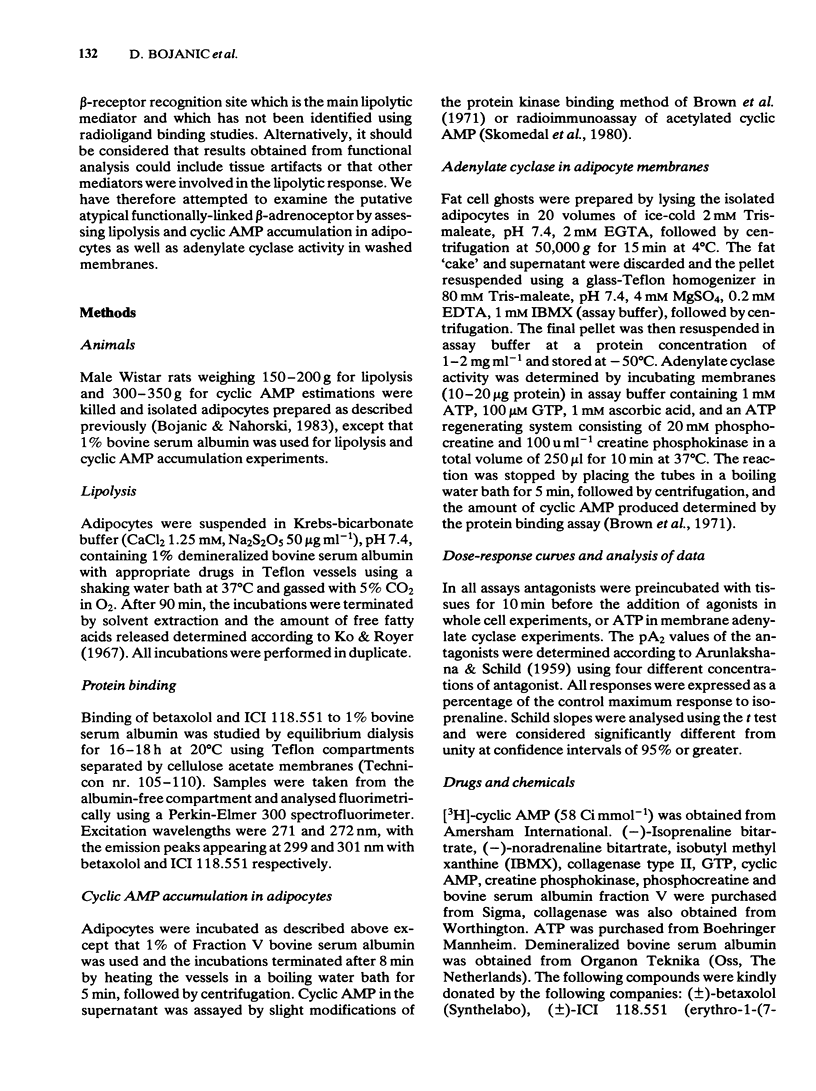
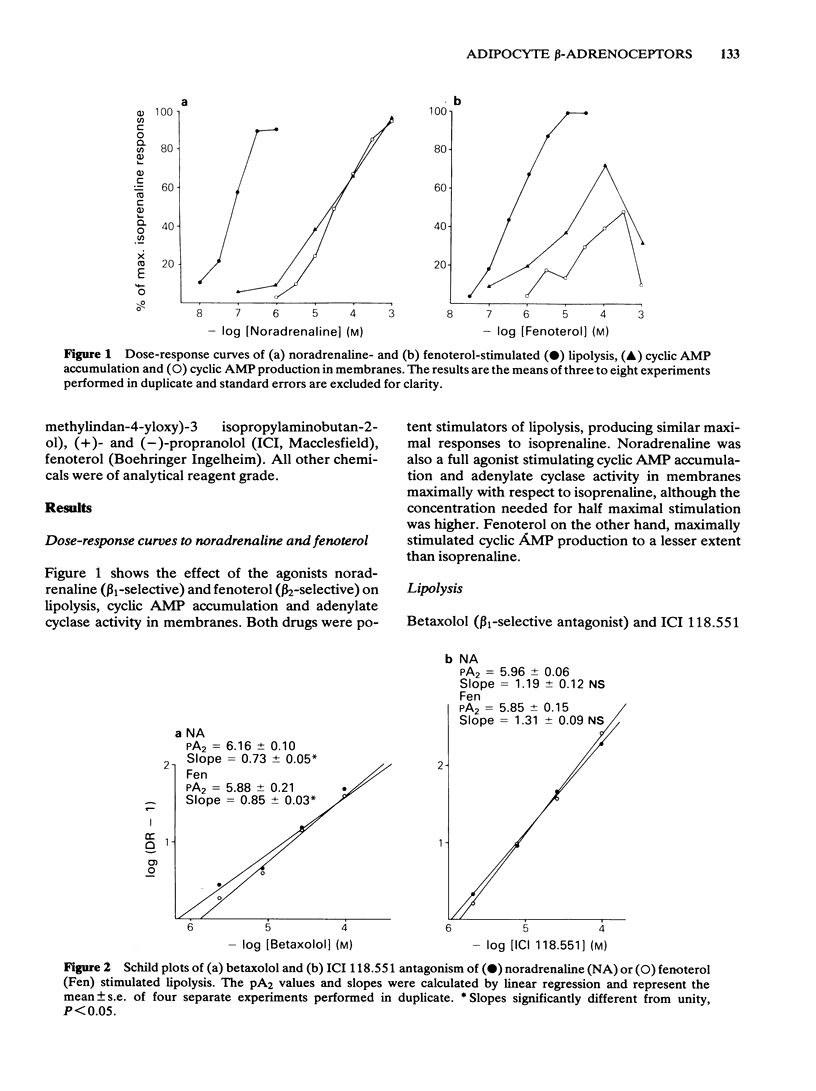
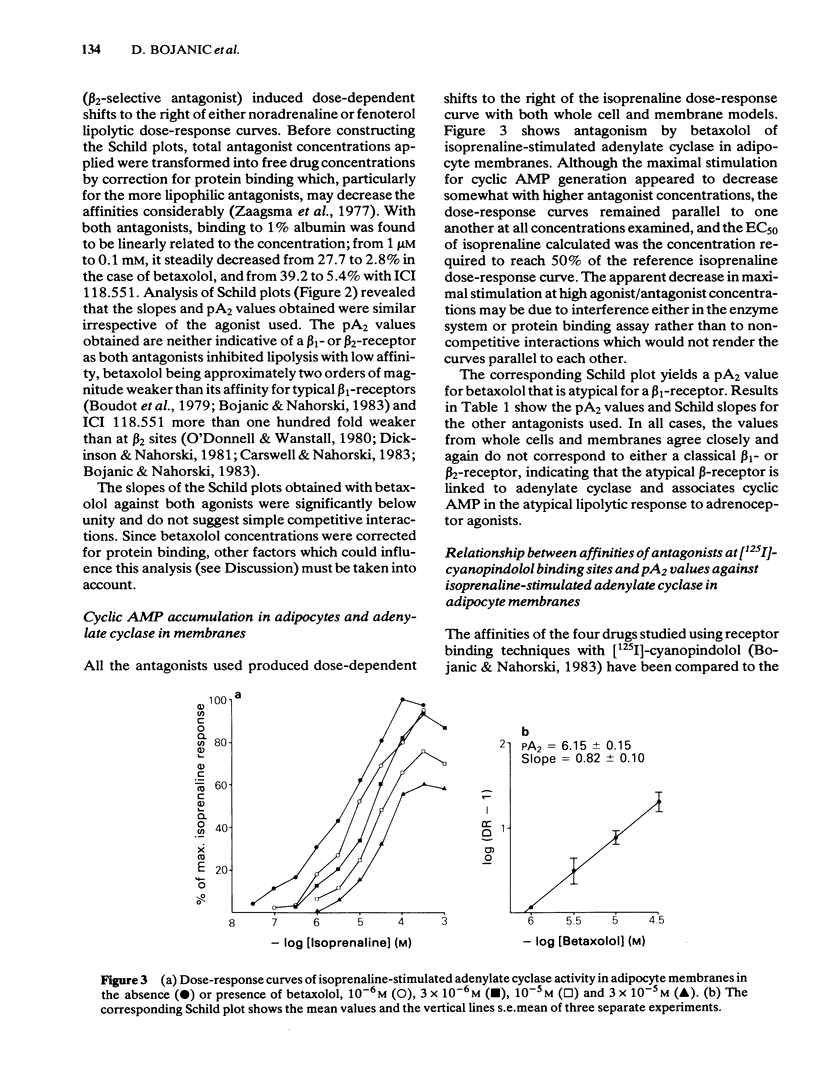
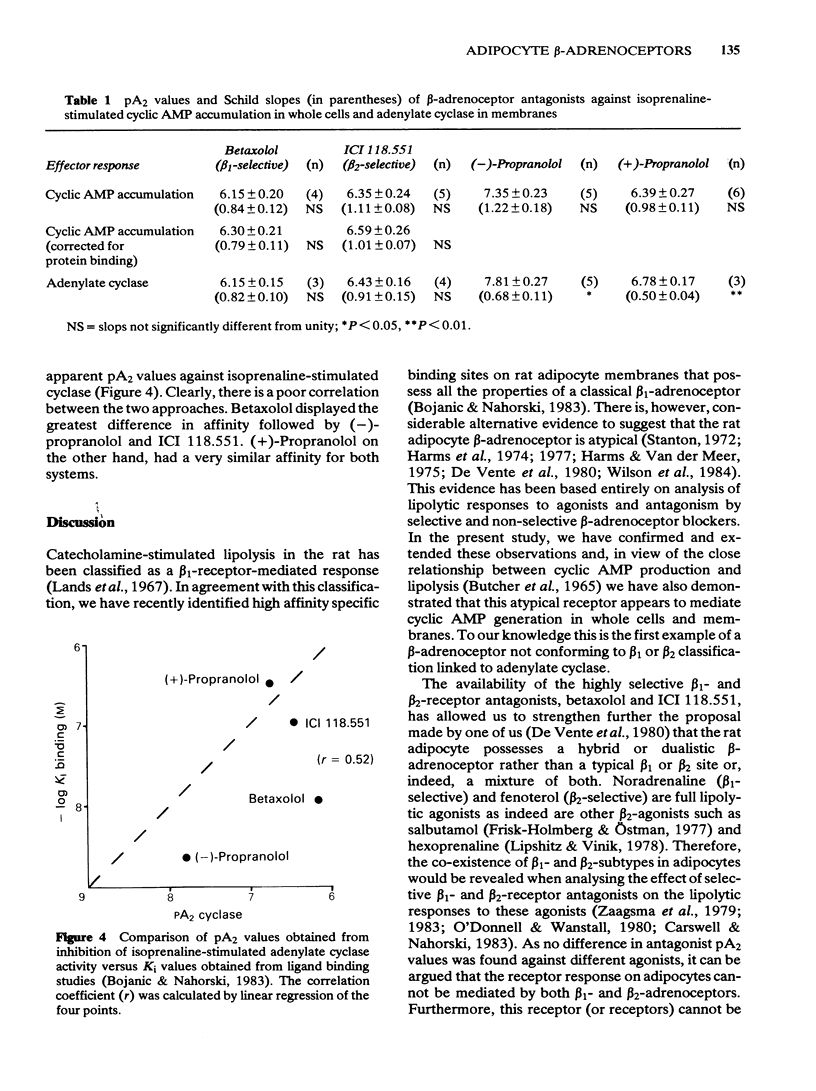
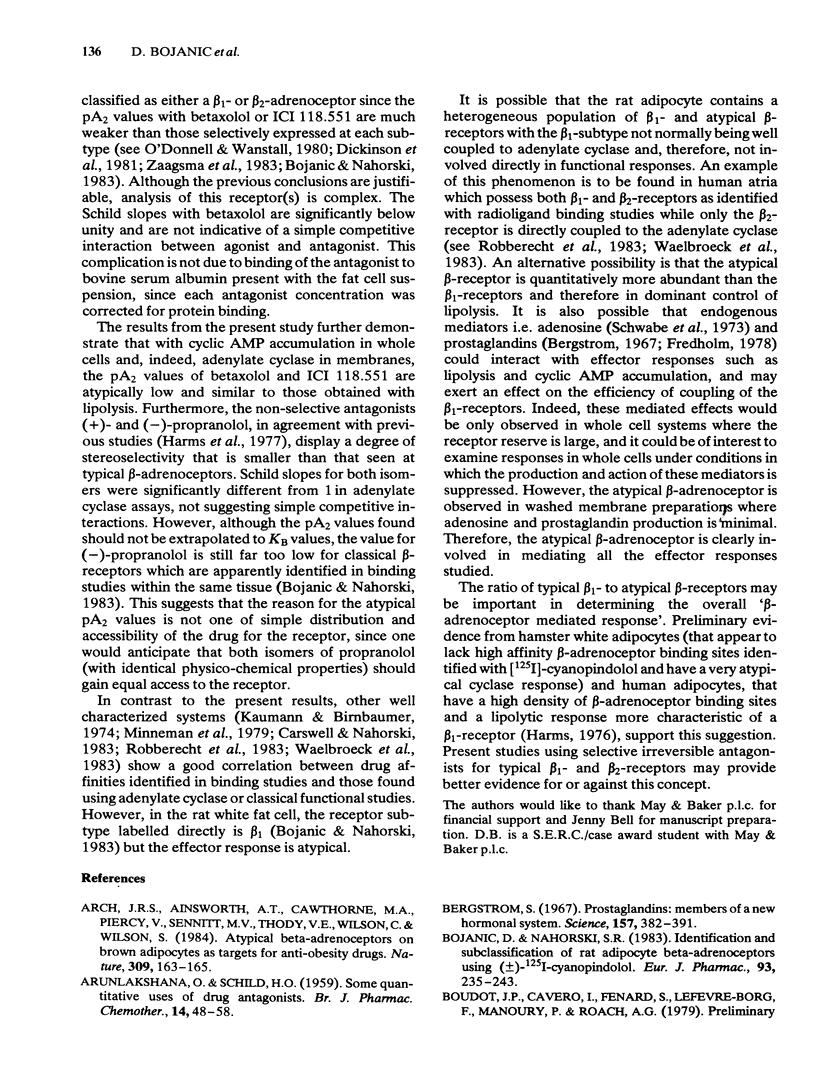
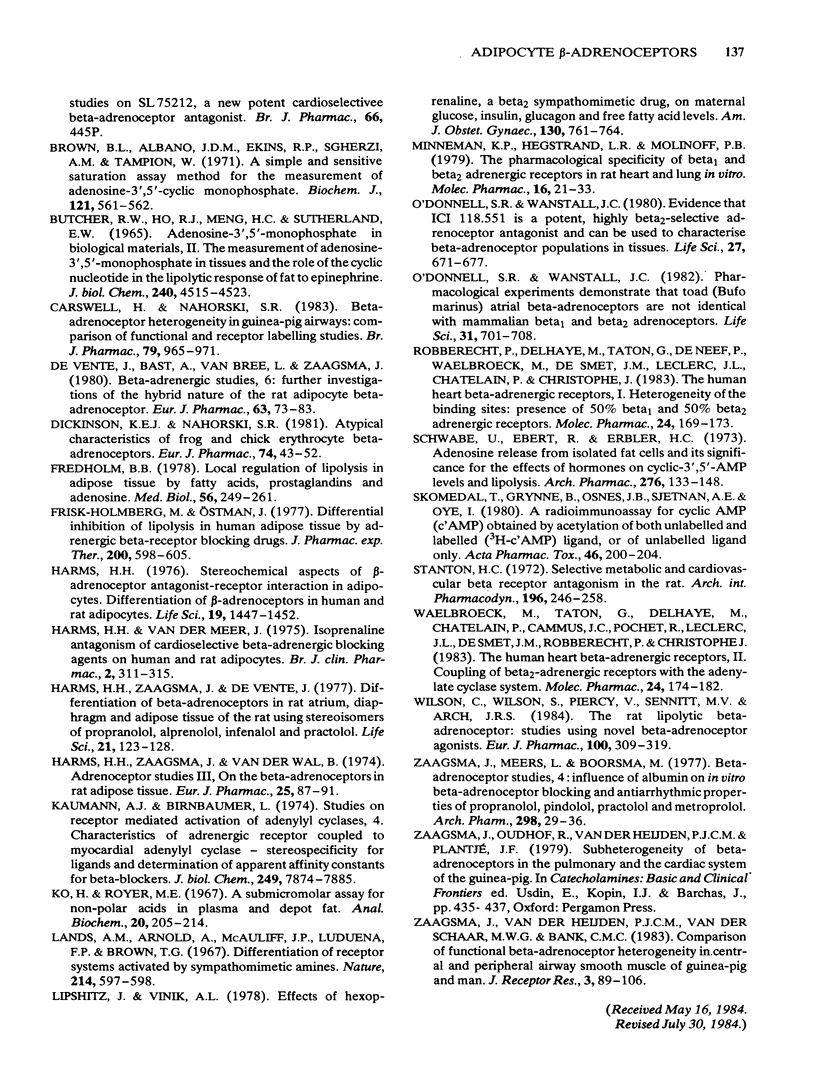
Selected References
These references are in PubMed. This may not be the complete list of references from this article.
- ARUNLAKSHANA O., SCHILD H. O. Some quantitative uses of drug antagonists. Br J Pharmacol Chemother. 1959 Mar;14(1):48–58. doi: 10.1111/j.1476-5381.1959.tb00928.x. [DOI] [PMC free article] [PubMed] [Google Scholar]
- Arch J. R., Ainsworth A. T., Cawthorne M. A., Piercy V., Sennitt M. V., Thody V. E., Wilson C., Wilson S. Atypical beta-adrenoceptor on brown adipocytes as target for anti-obesity drugs. Nature. 1984 May 10;309(5964):163–165. doi: 10.1038/309163a0. [DOI] [PubMed] [Google Scholar]
- Bergström S. Prostaglandins: members of a new hormonal system. These physiologically very potent compounds of ubiquitous occurrence are formed from essential fatty acids. Science. 1967 Jul 28;157(3787):382–391. doi: 10.1126/science.157.3787.382. [DOI] [PubMed] [Google Scholar]
- Bojanic D., Nahorski S. R. Identification and subclassification of rat adipocyte beta-adrenoceptors using (+/-)-[125I]cyanopindolol. Eur J Pharmacol. 1983 Sep 30;93(3-4):235–243. doi: 10.1016/0014-2999(83)90143-7. [DOI] [PubMed] [Google Scholar]
- Boudot J. P., Cavero I., Fénard S., Lefèvre-Borg F., Manoury P., Roach A. G. Preliminary studies on SL 75212, a new potent cardioselective beta-adrenoceptor antagonist [proceedings]. Br J Pharmacol. 1979 Jul;66(3):445P–445P. [PMC free article] [PubMed] [Google Scholar]
- Brown B. L., Albano J. D., Ekins R. P., Sgherzi A. M. A simple and sensitive saturation assay method for the measurement of adenosine 3':5'-cyclic monophosphate. Biochem J. 1971 Feb;121(3):561–562. doi: 10.1042/bj1210561. [DOI] [PMC free article] [PubMed] [Google Scholar]
- Butcher R. W., Ho R. J., Meng H. C., Sutherland E. W. Adenosine 3',5'-monophosphate in biological materials. II. The measurement of adenosine 3',5'-monophosphate in tissues and the role of the cyclic nucleotide in the lipolytic response of fat to epinephrine. J Biol Chem. 1965 Nov;240(11):4515–4523. [PubMed] [Google Scholar]
- Carswell H., Nahorski S. R. Beta-adrenoceptor heterogeneity in guinea-pig airways: comparison of functional and receptor labelling studies. Br J Pharmacol. 1983 Aug;79(4):965–971. doi: 10.1111/j.1476-5381.1983.tb10542.x. [DOI] [PMC free article] [PubMed] [Google Scholar]
- Dickinson K. E., Nahorski S. R. Atypical characteristics of frog and chick erythrocyte beta-adrenoceptors. Eur J Pharmacol. 1981 Aug 27;74(1):43–52. doi: 10.1016/0014-2999(81)90321-6. [DOI] [PubMed] [Google Scholar]
- Fredholm B. B. Local regulation of lipolysis in adipose tissue by fatty acids, prostaglandins and adenosine. Med Biol. 1978 Oct;56(5):249–261. [PubMed] [Google Scholar]
- Frisk-Holmberg M., Ostman J. Differential inhibition of lipolysis in human adipose tissue by adrenergic beta receptor blocking drugs. J Pharmacol Exp Ther. 1977 Mar;200(3):598–605. [PubMed] [Google Scholar]
- Harms H. H. Stereochemical aspects of beta-adrenoceptor antagonist-receptor interaction in adipocytes. Differentiation of beta-adrenoceptors in human and rat adipocytes. Life Sci. 1976 Nov 1;19(9):1447–1452. doi: 10.1016/0024-3205(76)90447-1. [DOI] [PubMed] [Google Scholar]
- Harms H. H., Van der Meer J. Isoprenaline antagonism of cardioselective beta-adrenergic receptor blocking agents on human and rat adipocytes. Br J Clin Pharmacol. 1975 Aug;2(4):311–315. doi: 10.1111/j.1365-2125.1975.tb02776.x. [DOI] [PMC free article] [PubMed] [Google Scholar]
- Harms H. H., Zaagsma J., Van der Wal B. Beta-adrenoceptor studies. III. On the beta-adrenoceptors in rat adipose tissue. Eur J Pharmacol. 1974 Jan;25(1):87–91. doi: 10.1016/0014-2999(74)90098-3. [DOI] [PubMed] [Google Scholar]
- Harms H. H., Zaagsma J., de Vente J. Differentiation of beta-adrenoceptors in right atrium, diaphragm and adipose tissue of the rat, using stereoisomers of propranolol, alprenolol, nifenalol and practolol. Life Sci. 1977 Jul 1;21(1):123–128. doi: 10.1016/0024-3205(77)90432-5. [DOI] [PubMed] [Google Scholar]
- Kaumann A. J., Birnbaumer L. Studies on receptor-mediated activation of adenylyl cyclases. IV. Characteristics of the adrenergic receptor coupled to myocardial adenylyl cyclase: stereospecificity for ligands and determination of apparent affinity constants for beta-blockers. J Biol Chem. 1974 Dec 25;249(24):7874–7885. [PubMed] [Google Scholar]
- Ko H., Royer M. E. A submicromolar assay for nonpolar acids in plasma and depot fat. Anal Biochem. 1967 Aug;20(2):205–214. doi: 10.1016/0003-2697(67)90026-7. [DOI] [PubMed] [Google Scholar]
- Lands A. M., Arnold A., McAuliff J. P., Luduena F. P., Brown T. G., Jr Differentiation of receptor systems activated by sympathomimetic amines. Nature. 1967 May 6;214(5088):597–598. doi: 10.1038/214597a0. [DOI] [PubMed] [Google Scholar]
- Lipshitz J., Vinik A. I. The effects of hexoprenaline, a beta 2-sympathomimetic drug, on maternal glucose, insulin, glucagon, and free fatty acid levels. Am J Obstet Gynecol. 1978 Apr 1;130(7):761–764. doi: 10.1016/0002-9378(78)90005-4. [DOI] [PubMed] [Google Scholar]
- Minneman K. P., Hegstrand L. R., Molinoff P. B. The pharmacological specificity of beta-1 and beta-2 adrenergic receptors in rat heart and lung in vitro. Mol Pharmacol. 1979 Jul;16(1):21–33. [PubMed] [Google Scholar]
- O'Donnell S. R., Wanstall J. C. Evidence that ICI 118, 551 is a potent, highly Beta 2-selective adrenoceptor antagonist and can be used to characterize Beta-adrenoceptor populations in tissues. Life Sci. 1980 Aug 25;27(8):671–677. doi: 10.1016/0024-3205(80)90008-9. [DOI] [PubMed] [Google Scholar]
- O'Donnell S. R., Wanstall J. C. Pharmacological experiments demonstrate that toad (Bufo marinus) atrial beta-adrenoceptors are not identical with mammalian beta 2- or beta 1-adrenoceptors. Life Sci. 1982 Aug 16;31(7):701–708. doi: 10.1016/0024-3205(82)90772-x. [DOI] [PubMed] [Google Scholar]
- Robberecht P., Delhaye M., Taton G., De Neef P., Waelbroeck M., De Smet J. M., Leclerc J. L., Chatelain P., Christophe J. The human heart beta-adrenergic receptors. I. Heterogeneity of the binding sites: presence of 50% beta 1- and 50% beta 2-adrenergic receptors. Mol Pharmacol. 1983 Sep;24(2):169–173. [PubMed] [Google Scholar]
- Schwabe U., Ebert R., Erbler H. C. Adenosine release from isolated fat cells and its significance for the effects of hormones on cyclic 3',5'-AMP levels and lipolysis. Naunyn Schmiedebergs Arch Pharmacol. 1973;276(2):133–148. doi: 10.1007/BF00501186. [DOI] [PubMed] [Google Scholar]
- Skomedal T., Grynne B., Osnes J. B., Sjetnan A. E., Oye I. A radioimmunoassay for cyclic AMP (cAMP) obtained by acetylation of both unlabeled and labeled (3H-cAMP) ligand, or of unlabeled ligand only. Acta Pharmacol Toxicol (Copenh) 1980 Mar;46(3):200–204. doi: 10.1111/j.1600-0773.1980.tb02443.x. [DOI] [PubMed] [Google Scholar]
- Stanton H. C. Selective metabolic and cardiovascular beta receptor antagonism in the rat. Arch Int Pharmacodyn Ther. 1972 Apr;196(2):246–258. [PubMed] [Google Scholar]
- Waelbroeck M., Taton G., Delhaye M., Chatelain P., Camus J. C., Pochet R., Leclerc J. L., De Smet J. M., Robberecht P., Christophe J. The human heart beta-adrenergic receptors. II. Coupling of beta 2-adrenergic receptors with the adenylate cyclase system. Mol Pharmacol. 1983 Sep;24(2):174–182. [PubMed] [Google Scholar]
- Wilson C., Wilson S., Piercy V., Sennitt M. V., Arch J. R. The rat lipolytic beta-adrenoceptor: studies using novel beta-adrenoceptor agonists. Eur J Pharmacol. 1984 May 4;100(3-4):309–319. doi: 10.1016/0014-2999(84)90007-4. [DOI] [PubMed] [Google Scholar]
- Zaagsma J., Meems L., Boorsma M. Beta-Adrenoceptor studies. 4. Influence of albumin on in vitro beta-adrenoceptor blocking and antiarrhythmic properties of propranolol, pindolol, practolol and metoprolol. Naunyn Schmiedebergs Arch Pharmacol. 1977 May;298(1):29–36. doi: 10.1007/BF00510983. [DOI] [PubMed] [Google Scholar]
- Zaagsma J., van der Heijden P. J., van der Schaar M. W., Bank C. M. Comparison of functional beta-adrenoceptor heterogeneity in central and peripheral airway smooth muscle of guinea pig and man. J Recept Res. 1983;3(1-2):89–106. doi: 10.3109/10799898309041925. [DOI] [PubMed] [Google Scholar]
- de Vente J., Bast A., Van Bree L., Zaagsma J. beta-Adrenoceptor studies. 6. Further investigations on the hybrid nature of the rat adipocyte beta-adrenoceptor. Eur J Pharmacol. 1980 Apr 11;63(1):73–83. doi: 10.1016/0014-2999(80)90118-1. [DOI] [PubMed] [Google Scholar]


